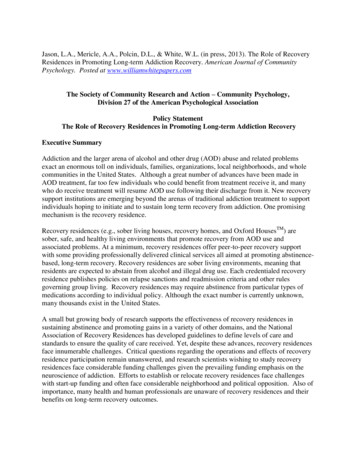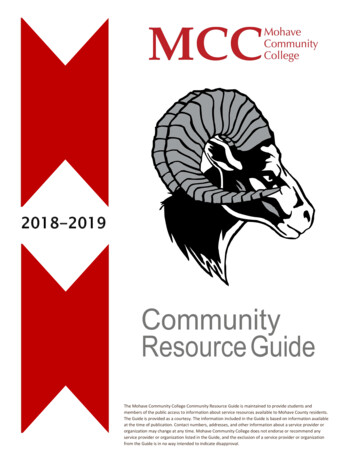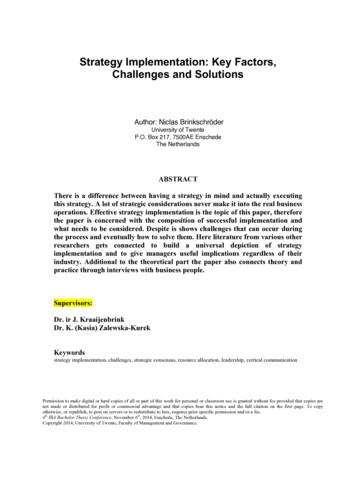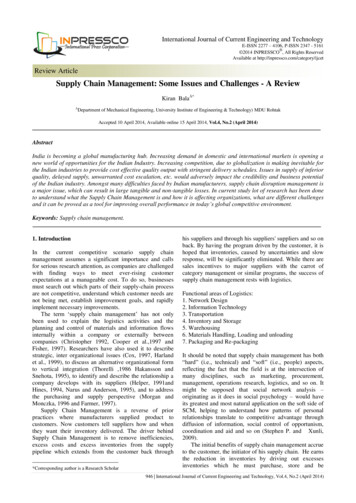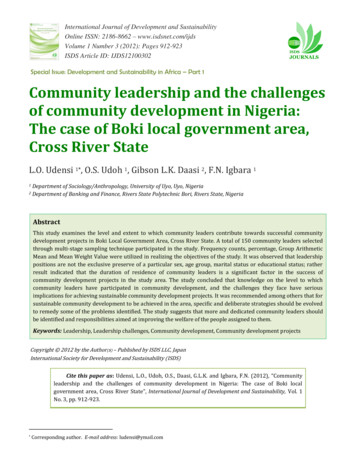
Transcription
International Journal of Development and SustainabilityOnline ISSN: 2186-8662 – www.isdsnet.com/ijdsVolume 1 Number 3 (2012): Pages 912-923ISDS Article ID: IJDS12100302Special Issue: Development and Sustainability in Africa – Part 1Community leadership and the challengesof community development in Nigeria:The case of Boki local government area,Cross River StateL.O. Udensi 1*, O.S. Udoh 1, Gibson L.K. Daasi 2, F.N. Igbara 112Department of Sociology/Anthropology, University of Uyo, Uyo, NigeriaDepartment of Banking and Finance, Rivers State Polytechnic Bori, Rivers State, NigeriaAbstractThis study examines the level and extent to which community leaders contribute towards successful communitydevelopment projects in Boki Local Government Area, Cross River State. A total of 150 community leaders selectedthrough multi-stage sampling technique participated in the study. Frequency counts, percentage, Group ArithmeticMean and Mean Weight Value were utilized in realizing the objectives of the study. It was observed that leadershippositions are not the exclusive preserve of a particular sex, age group, marital status or educational status; ratherresult indicated that the duration of residence of community leaders is a significant factor in the success ofcommunity development projects in the study area. The study concluded that knowledge on the level to whichcommunity leaders have participated in community development, and the challenges they face have seriousimplications for achieving sustainable community development projects. It was recommended among others that forsustainable community development to be achieved in the area, specific and deliberate strategies should be evolvedto remedy some of the problems identified. The study suggests that more and dedicated community leaders shouldbe identified and responsibilities aimed at improving the welfare of the people assigned to them.Keywords: Leadership, Leadership challenges, Community development, Community development projectsCopyright 2012 by the Author(s) – Published by ISDS LLC, JapanInternational Society for Development and Sustainability (ISDS)Cite this paper as: Udensi, L.O., Udoh, O.S., Daasi, G.L.K. and Igbara, F.N. (2012), “Communityleadership and the challenges of community development in Nigeria: The case of Boki localgovernment area, Cross River State”, International Journal of Development and Sustainability, Vol. 1No. 3, pp. 912-923.*Corresponding author. E-mail address: ludensi@ymail.com
International Journal of Development and SustainabilityVol.1 No.3 (2012): 912-9231. IntroductionAchieving a successful or sustainable community development project in Cross River State has been ondiscourse for many years, but due to the challenges faced, its maximum goals are yet to be actualized. Centralto the challenges of community development is the issue of leadership (Governance) which believed to pose athreat to successful community development, citizens’ participation, mobilization and involvement indecision making in community development projects.Community development occurs when people strengthen the bounds within their neighbourhoods, buildsocial networks, and form their own organizations to provide a long-term capacity for problem solving(Rubin and Rubin, 200l). Community members who have the capacity to do something to enhance theirquality of life are portrayed as having the ability to think, to decide, to plan and to take action in determiningtheir lives. It is often argued that, in any community development programme both economic and individualgrowth must be given equal attention so as to ensure that the process of community development achievesits due balance, continuity and sustainability through its power structure (leadership).Various community development literature have been dedicated to community leaders and their role inlocal communities (Williams, 1989; Israel and Beaulieu, 1990; Ugboh, 2007; Zaharah and Abu, 2008; Ozorand Nwankwo, 2008). In his analysis of community leaders, Fariborz et al. (2009) states that “a communitywithout leadership may not be equipped to mobilize resources or influence tourism planning whichobviously is also an aspect of community development”. He further argued that, local communities, like otherorganizations cannot progress successfully without active and dynamic leaders who are willing and able totake initiative. To him also, the success of the local community initiative depends on the quality, creativityand commitment of its leadership in maintaining its daily affairs. In line with the view of Fariborz (2009),many scholars contend that promoting local leadership to help make communities better places to liveshould be one of the primary purposes of community development (Also see Bolton, 1991; Kirk and Kraft,2004; Mills, 2005). Several other literatures in community leadership such as Rost, 1991; Robinson, 1994;Langone and Rohs, 1995; Kouzes and posner, 1995; Northouse, 1997; Price and Behrens, 2003 collectivelysuggest that, community leadership emphasizes a collaborative, on-going, influential process based on therelationships between people. But contemporary views on community leadership emphasize the need forcitizens to voice their opinions and thoughts in shaping the decisions and policies that affect their lives (Rost,1991; Robinson, 1994; Langone, and Rohs, 1995; Kouzes and Posner, 1995; Northouse, 1997; Price andBehrens, 2003).It may be argued that a community without leadership may not be equipped to mobilize resources orinfluence community development projects. Local communities according to Aref and Ma’rof (2009) cannotproceed successfully without having dynamic leaders that are willing and able to take initiatives. Lack ofcapable community leaders is often mentioned by local people as a barrier to community development (Arefand Ma’rof, 2008).According to Rubin and Rubin (200l), community development is regarded as a continuous process aimedat improving the quality of life of the community. It is all about continual improvement by the peoplethemselves to bring about change in their lives which is usually driven by its power structure. The ultimateISDS www.isdsnet.com913
International Journal of Development and SustainabilityVol.1 No.3 (2012): 912-923goal of community development therefore is to develop members’ capabilities and potential to affect theirwell being and quality of life through maximizing resources utilization to benefit them socially andeconomically. This could only be achieved through effective management of community developmentprogrammes as well as having highly committed and enthusiastic leadership. Considering the role of localleaders in the success of community development projects, it can be argued that local leaders are the baseline to every successful community development project. A study in Imo State by Ozor and Nwakwo (2008)point out that the role of local leaders in community development programmes cannot be undermined. Thisstudy involves community leaders, and those individuals who were perceived as leaders of theircommunities, and as people who are interested and influential to the development of their communities. Ittherefore became imperative in this study to address the issue of community leadership challenge andprovide best practices for achieving successful community development projects.From the foregoing, this study is directly concerned with determining the level and extent to whichcommunity leaders have contributed towards successful community development projects in Boki, CrossRiver State. Specifically, the objectives pursued in this study are to:i.determine the personal characteristics of community leaders in the study area;ii.determine the level of participation of community leaders in successful community developmentprojects in the study area;iii.identify the challenges faced by community leaders in the course of achieving a successful communitydevelopment projects in the study area; andiv.make useful recommendations for sustainable community development projects in the study area.2. MethodologyThe study was carried out in Boki Local Government Area of Cross River State, Nigeria. The multi-stagesampling method was employed in selecting 6 wards out of the 11 wards in Boki Local Government Area. Ineach ward, 5 villages were randomly selected, while in each village, 5 community leaders were purposivelyselected, thereby making it a total of 150 community leaders. The study employed a structured questionnaireand interview schedule to realise its objectives. Likert scale structure was employed. The respondentsanswered each statement based on scales that most described the current situation in their community. Theinterview was conducted with a community leader in each of the villages selected for the study using aninterview guide of 5 open-ended questions. Tables, Percentages, group arithmetic mean (GAM) and meanweight values (MWV) were adopted in analysing quantitative data. Qualitative data were transcribed andsorted, and the content properly analysed.914ISDS www.isdsnet.com
International Journal of Development and SustainabilityVol.1 No.3 (2012): 912-9233. Results3.1. Personal characteristics of community leadersTable 1 shows details of personal characteristics of community leaders. Out of the 150 community leaders,the survey indicated that approximately 61% and 39.3% of the respondents were male and femalerespectively. About 26% were 20 – 35 years; 30% were 36 – 45 years; 24% were 46 -55 years while 21%were above 55 years of age. The respondents were predominately Christians (90%) and only about 10%were traditional worshipers, Atheist or Muslims.Data from the same table further revealed that, a little above a half of the respondents (55.3%) weremarried, about a little below one-quarter (23%) were single, while less than one-quarter (22%) weredivorced, separated or widowed. Also, less than one-quarter (22.7%) did not acquire any formal educationwhile about three-quarters, a large majority (77.3%), acquired formal education. Furthermore, data in thesame table show that about two-third (36%) of the respondents have resided in the community from 40years and above; less than one-quarter (22%) have lived between 31 – 40 years; less than one-quarter(21.4%) have lived between 21 – 30 years; and a little below two-fifth (11.3%) have lived between 11-20years; while a little below one-fifth (9.3%) have lived less than 10 years in the community.Findings from Table 1 show that leadership positions are not the exclusive preserve of a particular sex,age group or educational status. However, respondents noted that in few cases, educational level couldenhance the quality of decision taking and facilitate the understanding of crucial decision-making issues. Thelength or duration of residence also had a significant relationship with the category of persons considered forleadership position, and the success of any community development project.3.2. Levels of community leader’s participation in community development projectsThe levels of community leader’s participation were obtained through careful computation, as is shown inTable 2. The various aspects of participation identified include: decision making, community mobilization,financial contribution, project legitimization, planning the project, monitoring and evaluating the project,raising funds for the project, and organizing skilled and unskilled labour for the project.Results in Table 2 show that the level of participation by community leaders in community developmentproject in the study area was significantly high in raising funds for the project which ranks first (25.9),followed closely by making decision (25.4). Financial contribution towards the project was ranked third with(25); accepting and approving the project ranked fourth (24.4) while community mobilization ranked fifth(23.9). However, the result show low level of participation by community leaders in organizing skilled andunskilled labour for the project which was ranked sixth (20.6), monitoring and evaluating the project wasranked seventh (20), and planning the project which was ranked eighth (19.9). From the foregoing analysis,it can be deduced that there is a high level of participation (62.55%) by community leaders in variouscommunity development projects in the study area, and this has led to the success of various project studies.ISDS www.isdsnet.com915
International Journal of Development and SustainabilityVol.1 No.3 (2012): 912-923Table 1. Personal characteristics of the respondents (n nal WorshippersOthers135195900.763.3Marital 1822.755.31012100Educational LevelNo formal educationPrimary educationSecondary educationTertiary education2832375318.721.324.735.3Age (years)20-3536-4546-55 55ReligionChristianityIslam100Duration of Residence (years) 1020-Nov21-3031-4040 14173233549.311.321.42236100Source: Field survey, 2011916ISDS www.isdsnet.com
International Journal of Development and SustainabilityVol.1 No.3 (2012): 912-923Table 2. Distribution of Respondents According to their Level of Participation inCommunity Development Projects (n 150)ResponsesPointsScale1Effective2Non 106141140504491013113471413515å782272.7 27.366.7 33.370.7 29.394693.3 6.775.3 20.623.1-2.56th185.1Source: Field Survey, 2011MWV Mean Weight ValueGAM Group Arithmetic MeanD DifferenceHigh if MWV is greater than GAM and the difference is positive, but low if MWV is less than GAM and the difference is negative.3.3. Factors that hinder community leaders from achieving resultsData on factors that hinders community leaders from achieving results are presented in Table 3 and itoutlays some of the crucial challenges identified as hindering community leaders from achieving results inthe course of a community development project. The result show that out of the seven7 challengesconsidered, respondents perceived 5 as major challenge and 2 as not a challenge.The most important of the challenges perceived by respondents include, lack of fund which ranked first(80.7), lack of interest in community development project by the leader was ranked second (75.8),disagreement between community leaders and community members was ranked third (75.3), non-inclusionof the community members in the planning and execution of the project by community leaders was rankedfourth (74.7) and women discrimination in leadership position was ranked fifth (70.4). Conversely, the resultshows that low level of education of community leaders was not a challenge to community leaders in thecourse of achieving a successful community development project as it was ranked sixth (58.6) and lastly,community tradition or culture was also indicated as not posing any challenge to achieving a successfulcommunity development project in the study area (53.3).ISDS www.isdsnet.com917
International Journal of Development and SustainabilityVol.1 No.3 (2012): 912-923Table 3. Distribution of respondents according to the perceived challenges faced inachieving a successful community development project (n 150)ResponsesPoints .669.8214429334448.751.353.369.8 6th7th488.4Source: Field Survey, 2011MWV Mean Weight ValueGAM Group Arithmetic MeanD DifferenceAccept if MWV is greater than GAM and the difference is positive, but reject if MWV is less than GAM and the difference is negative.During the verbal interview, some of the respondents observed that certain challenges often hinder therealization of community development objectives by community leaders. They expressed their opinions asfollows:Extract 1:.Money will go a long way in helping the success of any project Most of the project carriedout would have been abandoned if there was no money to finance it.Extract 2:I don’t think I will participate in any project I was not involved in the planning process. Idon’t like surprises Extract 3:A kingdom that is divided will fall So if our leader has a disagreement with us (communitymembers) he will fail in all that he is doing because a tree cannot make a forest Extract 4:The community is made up of both men and women. Everybody should be given opportunityto perform discriminating against women can lead to failure in the project. After all, whata man can do, a woman can also do it.Extract 5:We do not have any tradition or culture that does not like good things or development ourculture is for good and development alone.Extract 6:.I don’t see education as anything that can prevent our leaders from performing in anyproject.Source: field Interview schedule, 2011918ISDS www.isdsnet.com
International Journal of Development and SustainabilityVol.1 No.3 (2012): 912-923The result or the extract from the interview is similar to the results or findings from the field survey asshown in Table 3.4. Discussion of findingsFindings from this study bring to focus that characteristic in community leaders can contribute or influencethe success of community development projects or programmes. Relating to the findings of this study, Fisher(2005) stated that the characteristics of leaders have significant impact on community development, whileSchultz (2004) states the importance of leader’s characteristics in community development effort. One of thekey characteristics as identified by one of our respondents is the period at which a leader or individualresides in the area. This finding is supported by Green et al. (1986) and Lawton (2005). Who state that,permanent residents may be more supportive of community development than seasonal residents. Lawton(2005) also adds that duration of residence in the community plays an important role in supportingcommunity development. According to Kuponiyi (2008), actual participation of community leaders in theexecution of community development projects could be a strong indicator for the progress of the project. Thesuccess of most community development project depends on community participation that is enabled by theleaders participating in the project. In line with the findings in Table3, it can be deduced that the level ofparticipation of community leaders is a strong indicator for the success of community development projects.Similarly, findings of this study also show that, lack of funds was a major challenge faced by communityleaders in the course of achieving a successful community development project. Similarly, it has beenobserved by Ugboh (2007) that insufficient funds have prevented many good ideas that were developed incommunities. To a large extent, as found from this study, if community leaders could not access funds it maylead to abandoned projects even as respondents noted in a study by Ozor and Nwankwo (2008), that therewere many abandoned projects in the community as a result of lack of funds to complete them.It is quite clear from the findings of this study that discrimination against women from holding leadershippositions will hinder community projects. The findings of Ozor and Nwankwo (2008) confirm strongly thatgender bias in community leadership adversely inhibits success in community development projects. But theoutcome of studies by, Farinde et al. (2004); Ajayi and Otuya (2006) and Zaharah and Abu (2008) indicatesthat women possess the necessary skills and capacity to deliver good programmes in the community, andeffectively accomplish community development projects. In their own studies, Zaharah and Abu (2008)observed that women, leadership relates more to a holistic and bottom-ups’ approach in developing thecommunity. This approach has a greater success and impact on community development compared to thetop-down approach commonly utilized by male community leaders. In conclusion, both men and womenshould be involved in leadership roles in community development so that they can complement each other’seffort where necessary (Ozor and Nwankwo, 2008).Furthermore, this study shows the importance of including community members in the planning andexecution of community development projects. In a similar study by Ogolo (1995), Asnarulkhadi andFariborz (2009) and Ekong (2010), people participate in developmental projects if they share in theISDS www.isdsnet.com919
International Journal of Development and SustainabilityVol.1 No.3 (2012): 912-923identification of the development priorities, planning and implementation. However, the result of this studydid not show low level of education, traditions and culture pose hindrances to community leader’s effortstoward achieving results in community development projects. This was justified as respondents interviewednoted that the level of education has no relationship to successful community development projects.5. ConclusionThe importance of community leadership in community development projects in Boki Local GovernmentArea cannot be debated. Community leadership is an important strategy enabling communities to respond tocommunity development project through active participation and taking of responsibilities. The findings ofthis study show that leadership positions in the study area are not the exclusive preserve of a particular sex,age group, educational status, religion or marital status. However, duration of residence has a significantrelationship with the success of community development projects in the study area. This implies that, thecommunity under study could develop faster if many more people who have interest in the development ofthe community are encouraged to live there. This calls for community peace initiative and provision of ruralamenities such as potable water, feeder roads, rural electricity and improved means of livelihood amongothers. Such amenities will encourage people to make permanent settlements in the area and in futurecontribute towards the development of the community. The issue of peace and harmony is necessary sincenobody would like to live or invest in an area of conflict and rancour. Rural dwellers must eschew violenceand embrace peace since this is one of the incidence that can make people live in the area.Also, community leaders in the study area had participated to a great extent in community developmentprojects. Thus their level of participation was high (62.5%). Respondent showed high level of participation indecision making, community mobilization, financial contribution, legitimizing the project, financialcontribution, and raising funds for the project. However, it was observed that their level of participation waslow in planning the project, monitoring and evaluating the project and organizing skilled and unskilledlabour for the project. The findings from the above show that although genuine efforts have beendemonstrated by the people toward community development projects, much is still need to be done to movethe community forward. For instance, proper and adequate mobilization is required particularly in areasidentified to have attracted less participation by the people. It points out to the fact that the elites inconsonant with government agencies must step up their efforts in order to encourage full participation bythe people.Different challenges were identified as hindrances to community leaders from achieving a successfulcommunity development project. Seven challenges were identified – lack of funds, discrimination againstwomen in leadership position, lack of leaders interest in the project, disagreement between members andleaders, non-inclusion of community members in the planning and execution of the project, low level ofeducation, tradition and culture. On the contrary, low level of education of community leaders, tradition andculture were not considered to be significant challenge to leaders in executing community developmentprojects in the study.920ISDS www.isdsnet.com
International Journal of Development and SustainabilityVol.1 No.3 (2012): 912-923This study therefore recommends that for sustainable community development to be achieved in the area,specific and deliberate strategies should be evolved to remedy some of the problems identified. The studysuggests that more and dedicated community leaders should be identified and responsibilities aimed atimproving the welfare of the people assigned to them. Also, every member of the community should be madeto contribute his or her quota towards community development projects, such contributions will enhancesustainability in terms of security, acceptability, usage and identification of the people with the said projects.ReferencesAjayi, A.R. and Otuya, N. (2006), “Women’s Participation in Self-help Community Development Projects inNdokwa Agricultural Zone of Delta State Nigeria”, Community Development Journal, Vol. 41 No. 2, pp. 189-208.Aref, F. and Ma’rof, R. (2008), “Barriers to Community Leadership in Tourism Development in Shiraz, Iran”,European Journal of Social Sciences, Vol. 7 No. 2, pp. 172-178.Aref, M. and Ma’rof, R. (2009), “Community Leaders’ Characteristics and their Effort in Building CommunityCapacity for Tourism Development in Local Communities”, International Journal of Business and Management,Vol. 4 No. 10, pp. 187 – 193.Asnarukhadi, A.S, and Fariorz, A. (2009), “People’s Participation in Community Development: A Case Study ina Planned Village Settlement in Malaysia”, World Rural Observation, Vol. 1 No. 2, pp. 45 – 54.Bolton, B. (1991), “Developing Local Leaders: Results of a Structural Learning Experience”, Journal of theCommunity Development Society, Vol. 22 No. 1, pp. 119-143.Ekong, E. E. (2010), Rural Sociology, 3rd ed., Dove, Uyo.Fariborz, Aref; Ma’rof, R. and Zahid, Emby. (2009), “Assessing Community Leadership Factor in CommunityCapacity Building in Tourism Development: A Case Study of Sairaz, Iran”, Journal of Human Ecology, Vol. 28No. 3, pp. 171- 176.Farinde, A.J., Okunade, E.O. and Laogun, E.A. (2004), “Community Perception of Women OccupyingLeadership Position in Rural Development Projects of Osun State, Nigeria”, Anthropologist, Vol. 6 No. 4, pp.273-278.Fisher, D.K. (2005), “Characteristics of Effective Leaders in Economic Development: An Exploratory Study”,available at: http://www.allbusiness.com/ 525131.html (accessed 10 October, 2010).Green, G.P., Marcouiller, D., Deller, S., Erkkila, D. and Sumathi, N.R. (1986), “Local Dependency, Land UseAttitudes, and Economic Development: Comparisons between Seasonal and Permanent Residents”, RuralSociology, Vol. 61 pp. 427-445.Israel, D. and Beaullieu, J. (1990), “Community Leadership”, in Luloff, A. and Swanson, L. (Ed.), AmericanRural Communities, Westview, San Francisco, CA.ISDS www.isdsnet.com921
International Journal of Development and SustainabilityVol.1 No.3 (2012): 912-923Kirk, P., and Kraft, K. (2004), “Community Leadership Development. Community Development”, Journal, Vol.39, pp. 234 – 251.Kouzes, J.M. and Posner, B.Z. (1995), “The Leadership Challenge: How to Keep Setting Extraordinary Thingsdone in Organization”, 2nd ed., Jessey–Bass, San Francisco.Kuponiyi, F. A. (2008), “Community Power Structure: The Role of Local Leaders in Community DevelopmentDecision Making in Ajaawa, Oyo State, Nigeria”, Anthropologist, Vol.10 No. 4, pp. 239-243.Langone, C.A. and Rohs, F.R. (1995), “Community Leadership Development: Process and Practice”, Journal ofthe Community Development Society, Vol. 26 No. 2, pp. 252-267.Lawton, L.J. (2005), “Residents Perceptions of Tourist Attraction on the Gold Coast of Australia”, Journal ofTravel Research, Vol. 44, pp. 188-200.Mills, C. (2005), “Sustainable Community Change: A New Paradigm for Leadership in CommunityRevitalization Efforts”, National Civic Review, Vol. 94, pp. 9-16.Northouse, P.G. (1997), “Leadership: Theory and Practice”, Sage, Thousand Oaks, CA.Ogolo, M.B. (1995), “Grassroots Participation in Rural Development: A Study of Selected Infrastructures in SomeCommunities of River State, Nigeria” Unpublished Ph.D. Thesis, University of Ibadan, Ibadan, Nigeria.Ozor, N and Nwankwo, N. (2008), “The Role of Local Leaders in Community Development programmes inIdeato Local Government Area of Imo State: Implication for Extension Policy”, Journal of AgriculturalExtension, Vol. 12 No. 2, pp. 63-75.Price, R.H. and Behrens, T. (2003), “Working Pasteur’s Quadrant: Harnessing Science and Action forCommunity Change”, American Journal of Community psychology, Vol. 31 No. 3&4, pp. 219 – 223.Robinson, J.W. (1994), “Ten Basic Principles of Leadership in Community Development Organizations,Journal of the Community Development Society, Vol. 25 No. 1, pp. 44-48.Rost, J.C (1991), “Leadership for the Twenty-first Century Leadership”, Journal of Extension, Vol. 33 No. 6, pp.1-9.Rubin, J. and Rubin, S. (2001), “Community Organizing and Development”, 3rd ed., Allyn and Bacon, Boston.Schultz, J. (2004), “Boomtown USA: The 7 keys to Big Success in Small Towns”, National Association ofIndustrial and Office Properties, Hemdon, VA.Ugboh, O. (2007), “Gender Differences in the Roles of Local Leaders in Rural and Community Development inDelta State, Nigeria”, Pakistan Journal of Social sciences, Vol. 4 No. 4, pp. 534-539.Wilkinson, K.P. (1991), “The Community in Rural America”, Great wood, New York, NY.Williams, M.R. (1989), “A Model for Deploying Rural Leadership in Community Economic Development”Southern Rural Sociological Association, Nashville, TN.Wimmer, R.D. and Dominick, J.R. (2000), “Mass Media Research: An Introduction, 6th ed., W
therefore became imperative in this study to address the issue of community leadership challenge and provide best practices for achieving successful community development projects. From the foregoing, this study is directly concerned with determining the level and extent to which community leaders have cont





